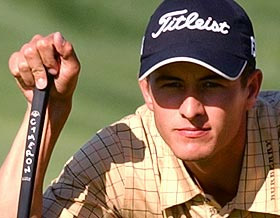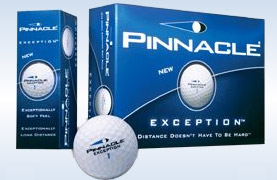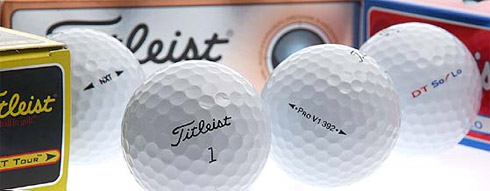 The golf equipment business is competitive and cutthroat. Take a look at the leaders in woods and irons over the last few decades. The dominant brands of the 1950s and 60s were MacGregor and Wilson, who were usurped in the 70s and 80s by Ping and Tommy Armour. Then came the boom of Big Bertha in the early 1990s, which catapulted Callaway to the top for a decade. Now TaylorMade stands poised to take the title of top woods and irons brand from Callaway.
The golf equipment business is competitive and cutthroat. Take a look at the leaders in woods and irons over the last few decades. The dominant brands of the 1950s and 60s were MacGregor and Wilson, who were usurped in the 70s and 80s by Ping and Tommy Armour. Then came the boom of Big Bertha in the early 1990s, which catapulted Callaway to the top for a decade. Now TaylorMade stands poised to take the title of top woods and irons brand from Callaway.
But through all those changes over the years, there’s essentially been one ball on top: Titleist. No other brand comes close at retail or on tour. How long can they keep it up?
I think of Titleist much the same way I think of Wal-Mart. Each has such a commanding lead over its competition. But nothing lasts forever. Just as those two category leaders edged out a former champ to take the title (pun intended), another brand or company will eventually come along to claim the top spot. Won’t they?
In the case of Wal-Mart – well, that’s playing from a different fairway for The Sand Trap. But let’s talk Titleist and what it might take for someone to take their place atop the ball biz.
When I say “Titleist” for the purposes of this discussion, I mean the Titleist and Pinnacle brands of Fortune Brands, a large holding company that also has the Cobra and FootJoy golf names. As you surely know, Pinnacle is the low-cost distance ball sister brand to Titleist. Both brands share R&D, production, and sales forces. But by delineating the high and low end of the market, the Titleist name can stay prestigious and high-margin, while the Pinnacle brand can gobble up sales in the under-$20 category. If you buy your balls by the 18-pack, you undoubtedly have a few Pinnacles in your bag.
 This two-pronged approach at retail has prompted the competition to follow suit, with less-than-stellar results. Top-Flite tried to go up-market by splitting off the Strata name while keeping the rest of the company’s ball products in the budget-conscious end of the pool. Unfortunately, the plan failed despite some strong Strata product thanks to a cash crunch caused after the KKR conglomerate bought the venerable Spalding Sports Worldwide company in the mid-90s. Now Top-Flite, with a de-emphasized Strata sub-brand, is itself a brand of Callaway Golf. Callaway probably stands as the best competition to Titleist at this point, with Nike, Maxfli and Bridgestone all trying to increase market share.
This two-pronged approach at retail has prompted the competition to follow suit, with less-than-stellar results. Top-Flite tried to go up-market by splitting off the Strata name while keeping the rest of the company’s ball products in the budget-conscious end of the pool. Unfortunately, the plan failed despite some strong Strata product thanks to a cash crunch caused after the KKR conglomerate bought the venerable Spalding Sports Worldwide company in the mid-90s. Now Top-Flite, with a de-emphasized Strata sub-brand, is itself a brand of Callaway Golf. Callaway probably stands as the best competition to Titleist at this point, with Nike, Maxfli and Bridgestone all trying to increase market share.
But that shows how dominant the Titleist juggernaut is: no one is trying to overtake them, because it is a laughable goal at this point. The best the other ball brands can hope to do is steal some market share to have something to build upon. All the ball brands are fighting for space in your local golf shop. Think of it like the soda aisle at your grocery store (or Wal-Mart, heaven forbid). Titleist and Pinnacle are essentially the Coke and Pepsi, with plenty of shelf space for all their offerings. The rest of the golf ball companies are like RC, Faygo, or Shasta. They’re fighting to have a few bottles stacked near the big boys. Less product on the shelf means less sales. Pretty simple math.
On tour and in top amateur competition, the situation is similar. At the 2004 U.S. Amateur, 292 of the 312 players used Titleist golf balls. Whoa. How about the PGA Tour, the ultimate level of competition? At the first full-field event of the 2005 season, the Sony Open, 103 of the 149 players at the event had Titleist on the tee. Titleist racked up 152 professionals wins around the world last year, while Callaway was a distant second at 38.
Why is Titliest so dominant? On tour, it has to do with familiarity, money, performance, and money. Not necessarily in that order. Familiarity is important. A lot of tour players have played Titliest since they were kids (as pointed out in several TV commercials). And no one can deny that for high swing-speed players, the Pro V1 in all its flavors is a great ball. But money does play a part in the stranglehold. Titleist, like nearly every ball company, offers tee-up money and bonuses to players who use their balls. If that same player uses a combination of other Fortune Brands products – a Cobra utility club, some Vokey wedges, a Scotty Cameron putter, FootJoy shoes and glove – the money gets a lot bigger. Big enough that without a contract with the company, a player could get a few thousand dollars just for teeing up on Thursday. If you’re a struggling youngster on tour, that’s guaranteed money each week, enough to pay your caddie and your Motel 6 bill. If you’re a financially set veteran, that’s money to pay your caddie and tip the pilot of your private jet. Either way, it’s all good.
(Side note: Titleist is proud of the fact that they maintain this dominance despite seldom having the top player on the PGA Tour using their balls. Arnold Palmer, Jack Nicklaus, Tom Watson and Lee Trevino all used other brands at their peak. Ditto for Greg Norman. Tiger Woods used Titleist his first few years on tour, then went on a tear after switching to Nike balls. Pro V1 user Vijay Singh is a rare world No. 1 to play Titleist.)
 At retail, Titleist and Pinnacle dominate for similar reasons: performance and money. The performance refers to the balls themselves and the company as a marketing power. That’s where money also comes in. Each year Titleist and Pinnacle are all over the airwaves with commercials reinforcing their core messages (Titleist is for “serious golfers,” Pinnacle is for distance lovers). Golf shops want to stock merchandise that sells through, and Titleist golf balls are pretty much the only sure thing in the business, year after year. The marketing messages and tour usage keep the Titleist brand strong with golfers of all handicaps that aspire to play like the pros, which is a huge market. And Pinnacle is there to grab sales among those who don’t care as much about performance as price, which is another huge market. Nice setup.
At retail, Titleist and Pinnacle dominate for similar reasons: performance and money. The performance refers to the balls themselves and the company as a marketing power. That’s where money also comes in. Each year Titleist and Pinnacle are all over the airwaves with commercials reinforcing their core messages (Titleist is for “serious golfers,” Pinnacle is for distance lovers). Golf shops want to stock merchandise that sells through, and Titleist golf balls are pretty much the only sure thing in the business, year after year. The marketing messages and tour usage keep the Titleist brand strong with golfers of all handicaps that aspire to play like the pros, which is a huge market. And Pinnacle is there to grab sales among those who don’t care as much about performance as price, which is another huge market. Nice setup.
So, what would it take to topple Titleist? One scenario is the Big Bertha Bustout. A competitor could come up with a product that outperforms everything else on the market and creates a marketing and sales avalanche, not unlike the situation that propelled small company Callaway into the limelight after the original Big Bertha driver exploded onto the scene in 1992-93. Within three years, they were tops in woods sales and on their way to taking over in irons.
How would Titleist respond? By creating a similar product, or by positioning a product in a similar way to the breakout new product. Titleist has hundreds of golf ball patents that cover processes and technologies that aren’t currently used. They’re essentially landmines for competitors to try and design around. Look at Callaway’s experience in the ball business. It had to license a couple of Titleist’s patents for its first few ball offerings, then bought Top-Flite in large part to obtain a larger patent portfolio to avoid the patent space Titleist had carved out. This is a significant advantage for Titleist, and one that the company smartly guards with vigor. And don’t forget the USGA and all of its performance limitations. There’s only so much space left to innovate with golf balls.

Another scenario is the gradual decline. A competitor, say Nike, Maxfli, or Callaway, chips away at Titleist’s market share and tour dominance a bit at a time, eventually evening the score. This would require a lot of money and a lot of patience, probably a decade or more of making a lot of shrewd moves and avoiding missteps. Unfortunately, patience isn’t a virtue for big companies that answer to shareholders. All three of the aforementioned competitors are publicly held companies that demand quick returns on investment. I don’t know that any of them have the stomach for a protracted battle and what it would cost. It isn’t so bad to be Avis, you know?
I would say the end of Titleist as the No. 1 golf ball brand on tour and at retail is most likely to come as the result of corporate game-playing. I can see a scenario where Fortune Brands would decide to spin its golf business off or sell it to an outside company. Sometimes, success is lost in transition. It happened at formerly dominant golf companies like MacGregor, Wilson, and Top-Flite. If a cost-cutting CEO took the reins at Titleist, the resulting loss of funds to the R&D, tour, and marketing departments would create vulnerability. Couple that with the possibility of another company building a better mousetrap or catching the public’s fancy at just the right moment, and you’d have the ingredients needed for Titleist to lose its crown.
I wouldn’t count on this happening any time soon. Decades of good will and good performance would help keep Titleist afloat in rough seas for a long time. But competition leads to winners and losers, and all winning streaks eventually come to an end. Or do they?
Photo Credits: © Titleist.com, PinnacleGolf.com, Titleist.com

I enjoyed reading this article. I also enjoyed the equipment reviews in this months’ Golf Digest. They place the pro v1 clearly in a league of its own, at the pinnacle( no pun intended) of all golf balls. No other comes close and the difference between it and its nearest competitior( callaway black, if I remember correctly)is the furthest for any golf product or category listed. I write this having never bought a sleeve or box of pro v1’s ( I feel my game is not up to the ball or its price). Im new to the game and the first time I break 100, I know what Im buying myself as a reward..Thanks Again
Just a little more fodder for the fire:
PGA TOUR: At the Ford Championship at Doral, which featured the strongest full field event of the year, more than five times as many players relied upon Titleist (99) golf balls than the nearest competitor (18). In fact, 7 of the 11 players who finished among the top 10 and ties trusted Titleist for their success including Vijay Singh (Pro V1x) and Zach Johnson (New Pro V1x) who tied for third place, David Toms (5th/New Pro V1), Jose Maria Olazabal (T6/New Pro V1), Retief Goosen (T8/Pro V1x), Angel Cabrera (T10/New Pro V1x) and Dudley Hart (T10/New Pro V1).
Fairhaven, MA (July 24, 2005) – Titleist has long been recognized for its golf ball usage and success across the worldwide professional tours, with club professionals and at every level of competitive golf. As the country’s top junior boy golfers gathered last week at the Longmeadow Country Club in Massachusetts for their national championship, an overwhelming 147 of the 156 players, more than 94 percent of the field, relied upon Titleist golf balls. The nearest competitor had four players. In addition to its golf ball success, Titleist also was the top choice across every major equipment category, including drivers (79), fairway metals (85), iron sets (76), utility irons (32), sand, lob and approach wedges (196) and putters (90).
U.S. JUNIOR AMATEUR CHAMPIONSHIP EQUIPMENT COUNTS
GOLF BALLS:
TITLEIST 147 94.2%
Nearest Competitor 4
DRIVERS:
TITLEIST 79 50.6%
Nearest Competitor 34
FAIRWAY METALS:
TITLEIST 85 36.5%
Nearest Competitor 63
IRONS:
TITLEIST 76 48.7%
Nearest Competitor 18
UTILITY IRONS
TITLEIST 32 76.2%
Nearest Competitor 5
WEDGES:
TITLEIST 196 56.6%
Nearest Competitor 87
PUTTERS:
TITLEIST 90 57.7%
Nearest Competitor 33
GLOVES:
FOOTJOY 77 49.4%
TITLEIST 58 37.2%
None 9
U.S. GIRLS’ JUNIOR AMATEUR CHAMPIONSHIP
GOLF BALLS:
TITLEIST 128 82.1%
Nearest Competitor 18
DRIVERS:
TITLEIST 43 27.6%
Nearest Competitor 27
FAIRWAY METALS:
TITLEIST 56**
IRONS:
TITLEIST 30**
WEDGES:
TITLEIST 91*
PUTTERS:
TITLEIST 49*
GLOVES:
FOOTJOY 84 53.8%
TITLEIST 15 9.6%
* – Titleist was second in the Wedge and Putter counts and third in the
fairway metal and iron categories at the U.S. Girls’ Junior Championship.